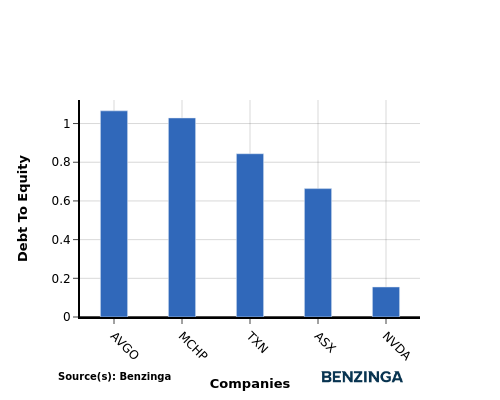In the dynamic and fiercely competitive business environment, conducting a thorough analysis of companies is crucial for investors and industry enthusiasts. In this article, we will perform an extensive industry comparison, evaluating NVIDIA (NASDAQ:NVDA) in relation to its major competitors in the Semiconductors & Semiconductor Equipment industry. By closely examining crucial financial metrics, market position, and growth prospects, we aim to offer valuable insights for investors and shed light on company's performance within the industry.
NVIDIA Background
Nvidia is a leading developer of graphics processing units. Traditionally, GPUs were used to enhance the experience on computing platforms, most notably in gaming applications on PCs. GPU use cases have since emerged as important semiconductors used in artificial intelligence. Nvidia not only offers AI GPUs, but also a software platform, Cuda, used for AI model development and training. Nvidia is also expanding its data center networking solutions, helping to tie GPUs together to handle complex workloads.
| Company | P/E | P/B | P/S | ROE | EBITDA (in billions) | Gross Profit (in billions) | Revenue Growth |
|---|---|---|---|---|---|---|---|
| NVIDIA Corp | 53.70 | 50.55 | 29.86 | 31.13% | $22.86 | $26.16 | 93.61% |
| Taiwan Semiconductor Manufacturing Co Ltd | 29.77 | 7.84 | 11.80 | 8.36% | $555.05 | $439.35 | 38.95% |
| Broadcom Inc | 133.13 | 11.73 | 16.32 | -2.77% | $6.39 | $8.36 | 47.27% |
| Advanced Micro Devices Inc | 124.89 | 4.02 | 9.50 | 1.36% | $1.55 | $3.42 | 17.57% |
| Texas Instruments Inc | 37.72 | 10.72 | 11.86 | 7.86% | $2.09 | $2.47 | -8.41% |
| Qualcomm Inc | 17.77 | 6.72 | 4.61 | 11.46% | $3.21 | $5.78 | 18.69% |
| ARM Holdings PLC | 230.92 | 24.42 | 41.98 | 1.83% | $0.11 | $0.81 | 4.71% |
| Micron Technology Inc | 149.26 | 2.57 | 4.65 | 1.99% | $3.63 | $2.74 | 93.27% |
| Analog Devices Inc | 67.34 | 3.15 | 11.50 | 1.11% | $1.04 | $1.31 | -24.84% |
| Microchip Technology Inc | 48.51 | 5.98 | 6.91 | 1.24% | $0.34 | $0.67 | -48.37% |
| ON Semiconductor Corp | 17.96 | 3.59 | 4.27 | 4.75% | $0.63 | $0.8 | -19.21% |
| Monolithic Power Systems Inc | 67.74 | 12.46 | 14.42 | 6.35% | $0.17 | $0.34 | 30.59% |
| STMicroelectronics NV | 10.60 | 1.32 | 1.70 | 1.98% | $0.74 | $1.23 | -26.63% |
| ASE Technology Holding Co Ltd | 19.79 | 2.27 | 1.19 | 3.16% | $28.59 | $26.43 | 3.85% |
| First Solar Inc | 16.61 | 2.72 | 5.38 | 4.22% | $0.45 | $0.45 | 10.81% |
| United Microelectronics Corp | 10.90 | 1.52 | 2.44 | 4.0% | $29.73 | $20.43 | 5.99% |
| Skyworks Solutions Inc | 23.83 | 2.22 | 3.40 | 0.95% | $0.18 | $0.43 | -15.9% |
| MACOM Technology Solutions Holdings Inc | 130.16 | 8.70 | 13.65 | 2.67% | $0.05 | $0.11 | 33.47% |
| Universal Display Corp | 34 | 5.07 | 12.53 | 4.29% | $0.08 | $0.13 | 14.57% |
| Lattice Semiconductor Corp | 56.35 | 11.27 | 14.16 | 1.03% | $0.03 | $0.09 | -33.87% |
| Average | 64.59 | 6.75 | 10.12 | 3.47% | $33.37 | $27.12 | 7.5% |
When conducting a detailed analysis of NVIDIA, the following trends become clear:
-
A Price to Earnings ratio of 53.7 significantly below the industry average by 0.83x suggests undervaluation. This can make the stock appealing for those seeking growth.
-
It could be trading at a premium in relation to its book value, as indicated by its Price to Book ratio of 50.55 which exceeds the industry average by 7.49x.
-
The Price to Sales ratio of 29.86, which is 2.95x the industry average, suggests the stock could potentially be overvalued in relation to its sales performance compared to its peers.
-
With a Return on Equity (ROE) of 31.13% that is 27.66% above the industry average, it appears that the company exhibits efficient use of equity to generate profits.
-
The company has lower Earnings Before Interest, Taxes, Depreciation, and Amortization (EBITDA) of $22.86 Billion, which is 0.69x below the industry average. This potentially indicates lower profitability or financial challenges.
-
Compared to its industry, the company has lower gross profit of $26.16 Billion, which indicates 0.96x below the industry average, potentially indicating lower revenue after accounting for production costs.
-
The company's revenue growth of 93.61% is notably higher compared to the industry average of 7.5%, showcasing exceptional sales performance and strong demand for its products or services.
Debt To Equity Ratio

The debt-to-equity (D/E) ratio assesses the extent to which a company relies on borrowed funds compared to its equity.
Considering the debt-to-equity ratio in industry comparisons allows for a concise evaluation of a company's financial health and risk profile, aiding in informed decision-making.
In terms of the Debt-to-Equity ratio, NVIDIA stands in comparison with its top 4 peers, leading to the following comparisons:
-
When considering the debt-to-equity ratio, NVIDIA exhibits a stronger financial position compared to its top 4 peers.
-
This indicates that the company has a favorable balance between debt and equity, with a lower debt-to-equity ratio of 0.16, which can be perceived as a positive aspect by investors.
Key Takeaways
The low P/E ratio suggests that NVIDIA may be undervalued compared to its peers in the Semiconductors & Semiconductor Equipment industry. However, the high P/B and P/S ratios indicate that the market values the company's assets and sales more highly. On the other hand, the high ROE and revenue growth, along with low EBITDA and gross profit, may indicate potential for strong future performance and market share growth within the industry.
This article was generated by Benzinga's automated content engine and reviewed by an editor.







